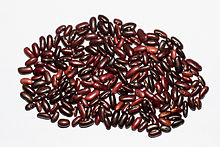The kidney bean is a variety of the common bean (Phaseolus vulgaris) named for its resemblance to a human kidney.

| Nutritional value per 100 g (3.5 oz) | |
|---|---|
| Energy | 532 kJ (127 kcal) |
22.8 g | |
| Sugars | 0.3 g |
| Dietary fiber | 7.4 g |
0.50 g | |
8.7 g | |
| Vitamins | Quantity %DV† |
| Thiamine (B1) | 13% 0.16 mg |
| Riboflavin (B2) | 5% 0.06 mg |
| Niacin (B3) | 4% 0.58 mg |
| Pantothenic acid (B5) | 4% 0.22 mg |
| Vitamin B6 | 7% 0.12 mg |
| Folate (B9) | 33% 130 μg |
| Vitamin C | 1% 1.2 mg |
| Vitamin E | 0% 0.03 mg |
| Vitamin K | 7% 8.4 μg |
| Minerals | Quantity %DV† |
| Calcium | 2% 28 mg |
| Copper | 27% 0.24 mg |
| Iron | 16% 2.9 mg |
| Magnesium | 11% 45 mg |
| Phosphorus | 11% 142 mg |
| Potassium | 13% 403 mg |
| Sodium | 0% 2 mg |
| Zinc | 10% 1.07 mg |
| Other constituents | Quantity |
| Water | 67 g |
| †Percentages estimated using US recommendations for adults,[1] except for potassium, which is estimated based on expert recommendation from the National Academies.[2] | |
There are different classifications of kidney beans, such as:
Kidney beans, cooked by boiling, are 67% water, 23% carbohydrates, 9% protein, and contain negligible fat. In a 100-gram reference amount, cooked kidney beans provide 532 kJ (127 kcal) of food energy, and are a rich source (20% or more of the Daily Value, DV) of protein, folate (33% DV), iron (22% DV), and phosphorus (20% DV), with moderate amounts (10–19% DV) of thiamine, copper, magnesium, and zinc (11–14% DV).
Red kidney beans are commonly used in chili con carne and are used in the cuisine of India, where the beans are known as rajma and Pakistan where they are called surkh lobia. Red kidney beans are used in southern Louisiana for the classic Monday Creole dish of red beans and rice. The smaller, darker red beans are also used, particularly in Louisiana families with a recent Caribbean heritage. In Jamaica, they are referred to as red peas. Small kidney beans used in La Rioja, Spain, are called caparrones. In the Netherlands and Indonesia, kidney beans are usually served as a soup called brenebon.[3] In the Levant, a common dish consisting of kidney bean stew usually served with rice is known as fasoulia. To make bean paste, kidney beans are generally prepared from dried beans and boiled until they are soft, at which point the dark red beans are pulverized into a dry paste.
Red kidney beans contain relatively high amounts of phytohemagglutinin, and thus are more toxic than most other bean varieties if not pre-soaked and subsequently heated to the boiling point for at least 10 minutes. The US Food and Drug Administration recommends boiling for 30 minutes to ensure they reach a sufficient temperature long enough to completely destroy the toxin.[4] Cooking at the lower temperature of 80 °C (176 °F), such as in a slow cooker, is insufficient to denature the toxin and has been reported to cause food poisoning.[4] Canned red kidney beans, though, are safe to eat straight from the can, as they are cooked prior to being shipped. As few as five raw beans or a single undercooked kidney bean can cause severe nausea, diarrhea, vomiting, and abdominal pains.[5][6][7]
Consumers should boil the beans for at least 30 minutes to ensure that the product reaches sufficient temperature